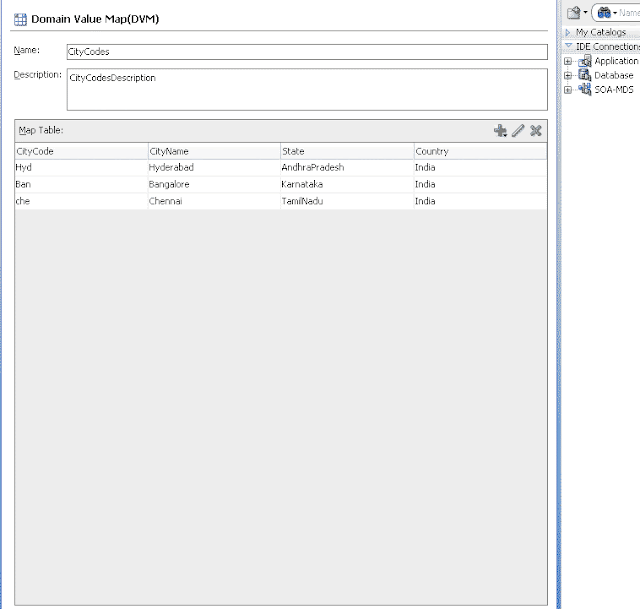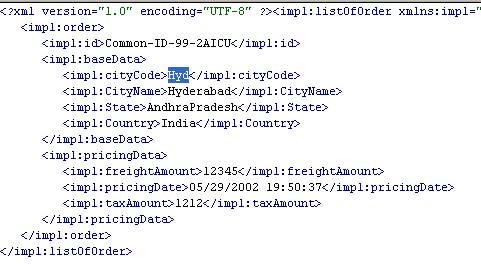In Oracle SOA 11g When ever we integrate the two applications with different names and it gives same information. A general example one application contains a city name as Hyderabad and another application contains the same city name as Hyd, the both the applications are different domains. These type of situations we can use a domain value map between the two domains.
How to create Domain Value Map
1. SOA Tier >> Transformations >> Domain Value Map >> OK
2. Enter the File Name and Description
3. Enter the Domain Name and Domain Value
Enter the Doamin value to the particular domain name and click on OK
4. Now you will get domain value editor
How to add Columns to Domain Value Map
Click on Add Column
The Create DVM Column Popup window is displayed
Enter the Name in the Name field
Select the True if you want to column as a Qualifier
Select Qualifier Order field enter a qualifier number (If you want enabled this field then select as true in Qualifier field)
Click on OK
How to add Rows to Domain Value Map
Click on Add Domain Values
One is added if you want to add one more click on Add Domain Value
Add values to the particular Column
Now the DVM is used for domain value mapping
1. Create the Project with Empty Composite
2. Add File Adapter in Exposed Services (i.e used for Read file)
3. Add File Adapter in External Services (i.e used for Writing file)
4. The Two Adapter connect with the Mediator
Create XSD File in the XSD Folder
Step1- Add File Adapter to Exposed Services
Drag the File Adapter from Component Palette to Exposed Services
Step2- Add File Adapter to External Services
Step3- Add the Mediator in the Components
Click on Transform Using Icon
If you select the Advanced tab then you will get DVM Functions
Now add lookupValue in the middle which element do you want lookup
When you double click on the DVM function Popup window will appear
Here Main step will raise
Add dvmlocation, if you click on magnifying glass icon then you will add The domain value map URI.
Add sourceColumnName
Add targetColumnName
Add defaultValue
Add qualifierColumnName
Add qualifierValue
Deploy the files in the server
Add xml to particular directory
If the value is correct the XML File is Like this
If the value is not valid The file is like this
How to create Domain Value Map
1. SOA Tier >> Transformations >> Domain Value Map >> OK
2. Enter the File Name and Description
3. Enter the Domain Name and Domain Value
Enter the Doamin value to the particular domain name and click on OK
4. Now you will get domain value editor
How to add Columns to Domain Value Map
Click on Add Column
The Create DVM Column Popup window is displayed
Enter the Name in the Name field
Select the True if you want to column as a Qualifier
Select Qualifier Order field enter a qualifier number (If you want enabled this field then select as true in Qualifier field)
Click on OK
Now on Column is Added
Repeat the same steps for adding one more column
How to add Rows to Domain Value Map
Click on Add Domain Values
One is added if you want to add one more click on Add Domain Value
Add values to the particular Column
Now the DVM is used for domain value mapping
1. Create the Project with Empty Composite
2. Add File Adapter in Exposed Services (i.e used for Read file)
3. Add File Adapter in External Services (i.e used for Writing file)
4. The Two Adapter connect with the Mediator
Create XSD File in the XSD Folder
Step1- Add File Adapter to Exposed Services
Drag the File Adapter from Component Palette to Exposed Services
Double click on the Mediator
Drag the listOfOrder from Source to Target
If the all the elements are same automatically mapping the data from source to target
Now add lookupValue in the middle which element do you want lookup
When you double click on the DVM function Popup window will appear
Here Main step will raise
Add dvmlocation, if you click on magnifying glass icon then you will add The domain value map URI.
Add sourceColumnName
Add targetColumnName
Add defaultValue
Add qualifierColumnName
Add qualifierValue
Deploy the files in the server
Add xml to particular directory
If the value is correct the XML File is Like this
If the value is not valid The file is like this






































This comment has been removed by a blog administrator.
ReplyDeleteThanks for sharing this blog. The content is beneficial and useful. Very informative post. Visit here to learn more about Data Warehousing companies and Data analytics Companies. I am impressed by the information that you have on this blog. Thanks once more for all the details.Visit here for Top Big Data Companies.
ReplyDelete